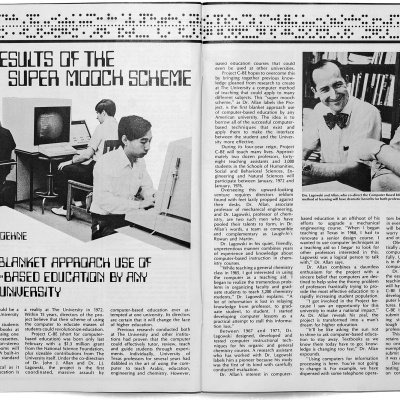History's New Home
UT’s Dolph Briscoe Center for American History gets a facelift—and a larger-than-life Jefferson Davis.

If you first heard of the Dolph Briscoe Center for American History when, in 2015, it was named as the final resting place of campus’ hotly debated Jefferson Davis statue, rest assured that you are not alone.
The announcement (and subsequent wealth of media coverage) shed light on what some already knew: The Briscoe Center is a campus gem, and has been for decades. Tucked away in the aging Sid Richardson Hall, the history research archive—home to 7 million documents, photographs and objects that could span 17 miles, end to end—has been a constant resource for generations of students, faculty, and researchers alike. It may lack the name recognition and yearly visitor numbers of the Harry Ransom Center or Blanton Museum of Art, but its shiny new digs, debuted last week, are set to make the center a destination in its own right.
After a fruitful fundraising campaign and an 18-month-long closure, the Briscoe Center revealed its renovated space on Monday, complete with an updated Reading Room, two new meeting spaces, and 4,000 square feet of new exhibition galleries.

“Although we are a research center, not a museum, we have created exhibition galleries that will finally give us the long-desired opportunity to display our treasures to visitors,” says Don Carleton, the Briscoe Center’s executive director. “The point is to show visitors just how much potential for understanding the past there is embedded in the center’s collections. These collections are at the heart of all of our endeavors, whether we’re talking about documentaries, books, digital projects, or exhibits.”
The center’s redesign, completed by Austin-based architecture firm McKinney York, orients its entrance toward the LBJ Presidential Library, which attracts thousands of history-minded visitors each year. Its bright, airy entryway leads you toward three inaugural exhibitions of its own: “Exploring the American South,” which traces the evolution of the region from Revolution through Reconstruction; the Weatherby Map Collection, a selection of historical maps documenting American westward expansion; and “From Commemoration to Education,” home to the 8-foot-6, two-ton bronze Jefferson Davis.
When the statue’s relocation was announced nearly two years ago, the reasoning was context. After all, proper context facilitates understanding, provides meaning; and “From Commemoration to Education” delivers. While a fresh restored Davis looms large as the show’s centerpiece, it’s the surrounding cases of statue-related correspondence, photographs and sketches that allow you to truly explore its origin story.

In doing so, perhaps the most fascinating discovery you’ll make is that the statue, while most fiercely debated in recent years, has been mired in controversy since it was first commissioned by Major George Washington Littlefield in 1919. A Confederate veteran, Littlefield dreamt of an allegorical campus memorial that would honor Texans who died in the Civil War and World War II, while also addressing Reconciliation: juxtaposing Jefferson Davis, the “Pillar of the South and State’s Rights,” with Woodrow Wilson, the “Pillar of the Union and World’s Rights.” He called upon an Italian sculptor, Pompeo Coppini, for the project.
In a displayed manuscript of his 1949 memoir, Coppini himself ruminated presciently about the task at hand: “More and more as time goes by and new generations will be born, they will look at the Civil War as a blot on the pages of American history, and the Littlefield Memorial will be resented as keeping up the hatred between the Northern and Southern states.”
But still, he moved forward with the project. Along the way, there were bitter financial battles, scrapped plans, and even commentary on the inappropriateness of Davis’ facial expression and attire. After its completion, the statue was moved several times before taking up permanent residency in the South Mall, and even then, some were disgruntled: Coppini was quoted in a 1939 issue of the Daily Texan, lamenting architect Paul Cret’s plans for campus expansion, which isolated the statue from the Littlefield Memorial Fountain and diminished the intended symbolism of Reconciliation.
Such controversy continued into the modern age, and handwritten letters and memos gave way to tweets and hashtags. An interactive screen to Davis’ left invites you to follow the ongoing conversation, from sporadic calls for the statue’s removal in the 1950’s and 1960’s to the growing social media outrage that followed the Charleston church shooting of 2015. Scroll through relevant tweets from the likes of President Gregory Fenves, UT Student Government, DDCE, and reporters covering the story. These, juxtaposed with firsthand accounts from the likes of Littlefield, Coppini, and then-UT president Robert Vinson, provide a complete picture of Davis’ role within campus history.
Even so, it’s just the tip of the iceberg. Exhibits like this one implore you to dig deeper, explore further, question more—all roots of the Briscoe Center’s mission as a history research archive. Simply put, there’s always more to learn. You may come to the galleries for Davis, but with any luck, you’ll wind up in the new Reading Room, getting hands-on with history.
The Dolph Briscoe Center for American History is open to the public Monday–Friday, 10 a.m.–5 p.m., and Saturday, 9 a.m.– 1 p.m.
Photos courtesy of the Briscoe Center.






